Globalization and Sweatshops: Impact on Bangladesh and Canada
VerifiedAdded on 2023/05/31
|6
|1163
|175
Essay
AI Summary
This essay delves into the intricate relationship between globalization and sweatshops, focusing on the implications of the garment industry in Bangladesh and its impact on the Canadian market. It explores the rise of sweatshops due to the outsourcing of manufacturing facilities to developing countries, where cheap labor is abundant. The study highlights the unsafe working conditions, low wages, and exploitation of workers, particularly young girls, in the Bangladeshi garment industry, referencing incidents like the Rana Plaza collapse. It analyzes the influence of sweatshop-produced goods on the Canadian market, examining consumer behavior and the ethical considerations of purchasing products manufactured in such environments. The essay concludes by emphasizing the need to address the human rights violations and the poverty conditions that perpetuate sweatshop labor, calling for greater awareness and ethical consumption practices.
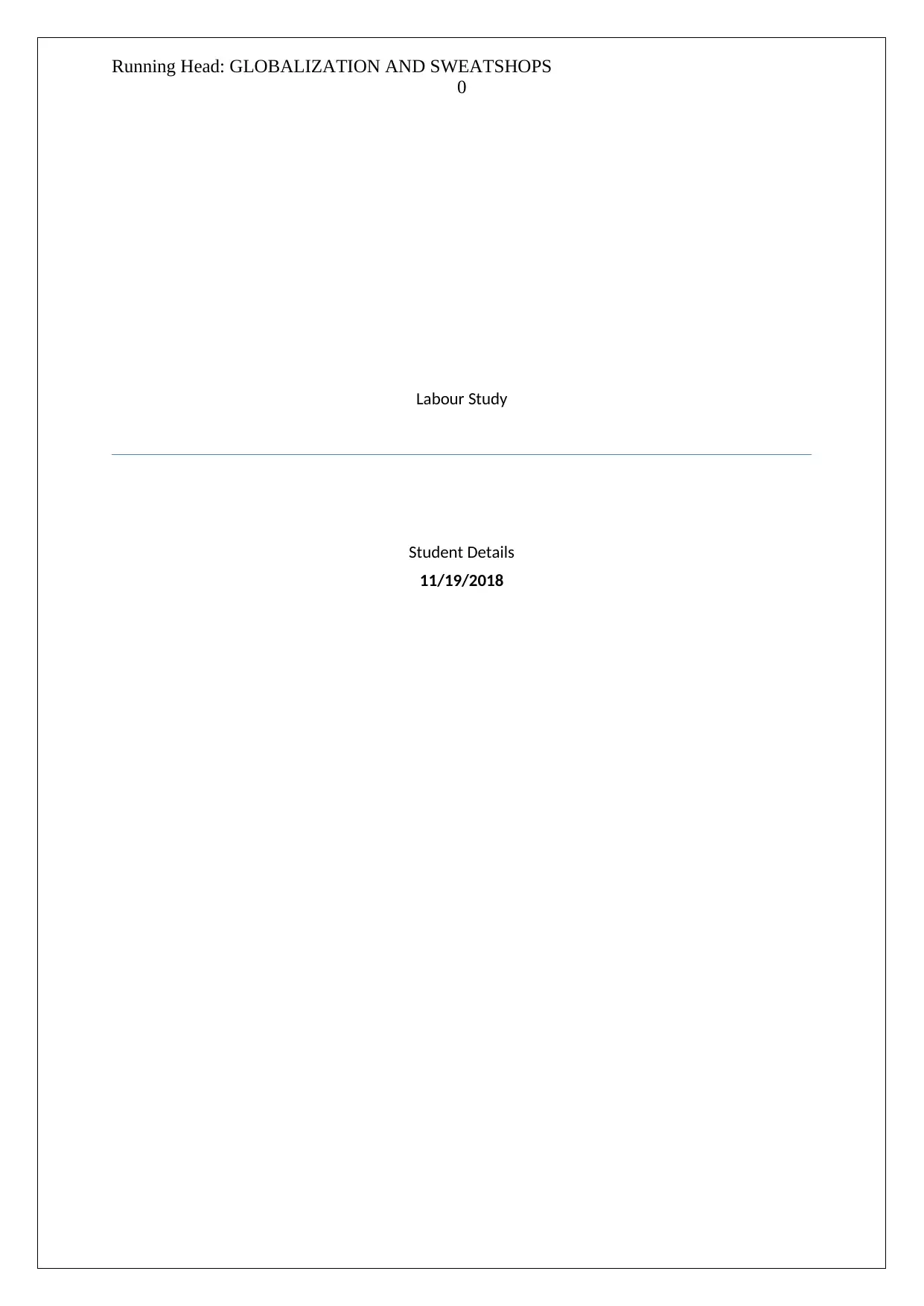
Running Head: GLOBALIZATION AND SWEATSHOPS
0
Labour Study
Student Details
11/19/2018
0
Labour Study
Student Details
11/19/2018
Paraphrase This Document
Need a fresh take? Get an instant paraphrase of this document with our AI Paraphraser
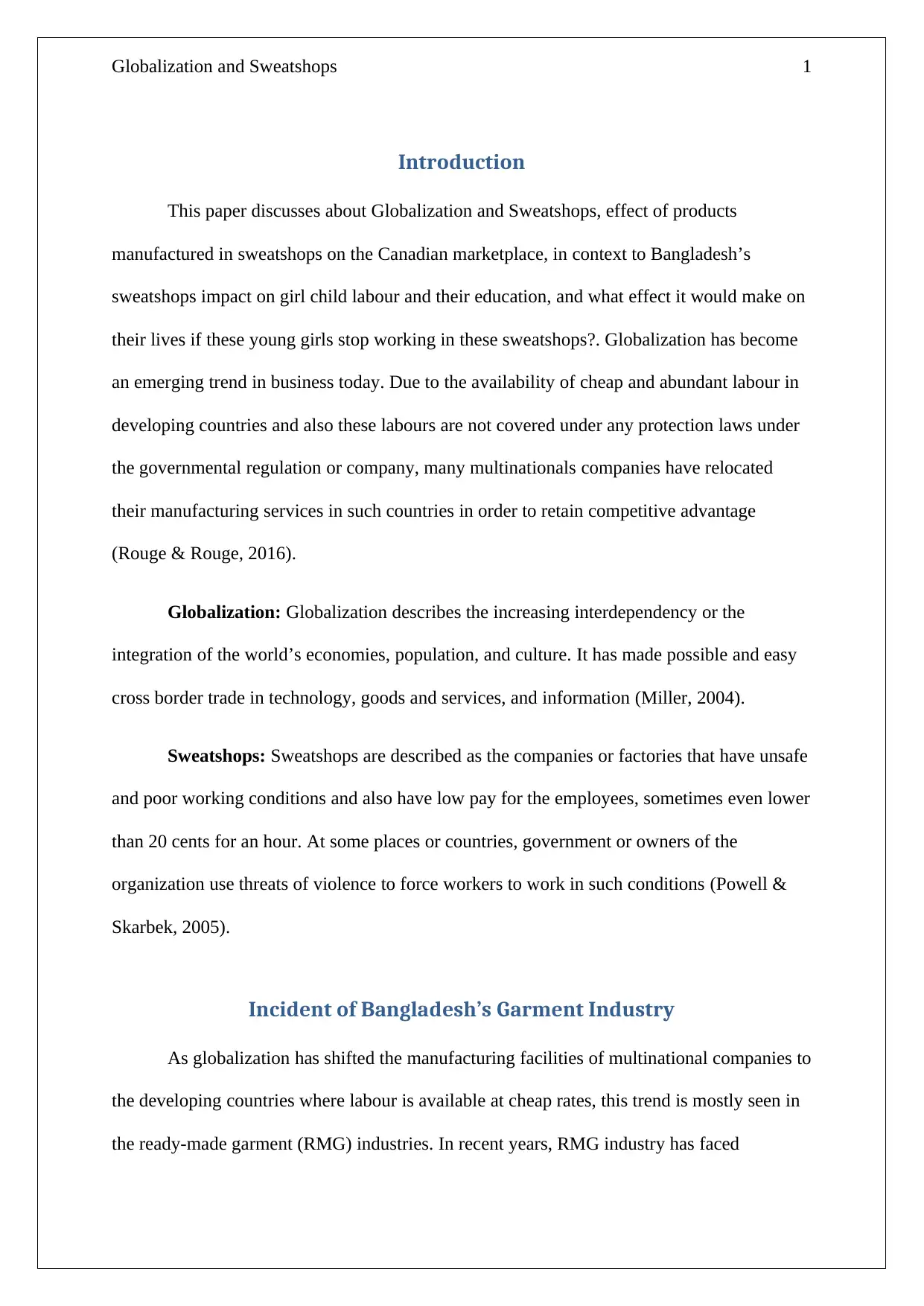
Globalization and Sweatshops 1
Introduction
This paper discusses about Globalization and Sweatshops, effect of products
manufactured in sweatshops on the Canadian marketplace, in context to Bangladesh’s
sweatshops impact on girl child labour and their education, and what effect it would make on
their lives if these young girls stop working in these sweatshops?. Globalization has become
an emerging trend in business today. Due to the availability of cheap and abundant labour in
developing countries and also these labours are not covered under any protection laws under
the governmental regulation or company, many multinationals companies have relocated
their manufacturing services in such countries in order to retain competitive advantage
(Rouge & Rouge, 2016).
Globalization: Globalization describes the increasing interdependency or the
integration of the world’s economies, population, and culture. It has made possible and easy
cross border trade in technology, goods and services, and information (Miller, 2004).
Sweatshops: Sweatshops are described as the companies or factories that have unsafe
and poor working conditions and also have low pay for the employees, sometimes even lower
than 20 cents for an hour. At some places or countries, government or owners of the
organization use threats of violence to force workers to work in such conditions (Powell &
Skarbek, 2005).
Incident of Bangladesh’s Garment Industry
As globalization has shifted the manufacturing facilities of multinational companies to
the developing countries where labour is available at cheap rates, this trend is mostly seen in
the ready-made garment (RMG) industries. In recent years, RMG industry has faced
Introduction
This paper discusses about Globalization and Sweatshops, effect of products
manufactured in sweatshops on the Canadian marketplace, in context to Bangladesh’s
sweatshops impact on girl child labour and their education, and what effect it would make on
their lives if these young girls stop working in these sweatshops?. Globalization has become
an emerging trend in business today. Due to the availability of cheap and abundant labour in
developing countries and also these labours are not covered under any protection laws under
the governmental regulation or company, many multinationals companies have relocated
their manufacturing services in such countries in order to retain competitive advantage
(Rouge & Rouge, 2016).
Globalization: Globalization describes the increasing interdependency or the
integration of the world’s economies, population, and culture. It has made possible and easy
cross border trade in technology, goods and services, and information (Miller, 2004).
Sweatshops: Sweatshops are described as the companies or factories that have unsafe
and poor working conditions and also have low pay for the employees, sometimes even lower
than 20 cents for an hour. At some places or countries, government or owners of the
organization use threats of violence to force workers to work in such conditions (Powell &
Skarbek, 2005).
Incident of Bangladesh’s Garment Industry
As globalization has shifted the manufacturing facilities of multinational companies to
the developing countries where labour is available at cheap rates, this trend is mostly seen in
the ready-made garment (RMG) industries. In recent years, RMG industry has faced
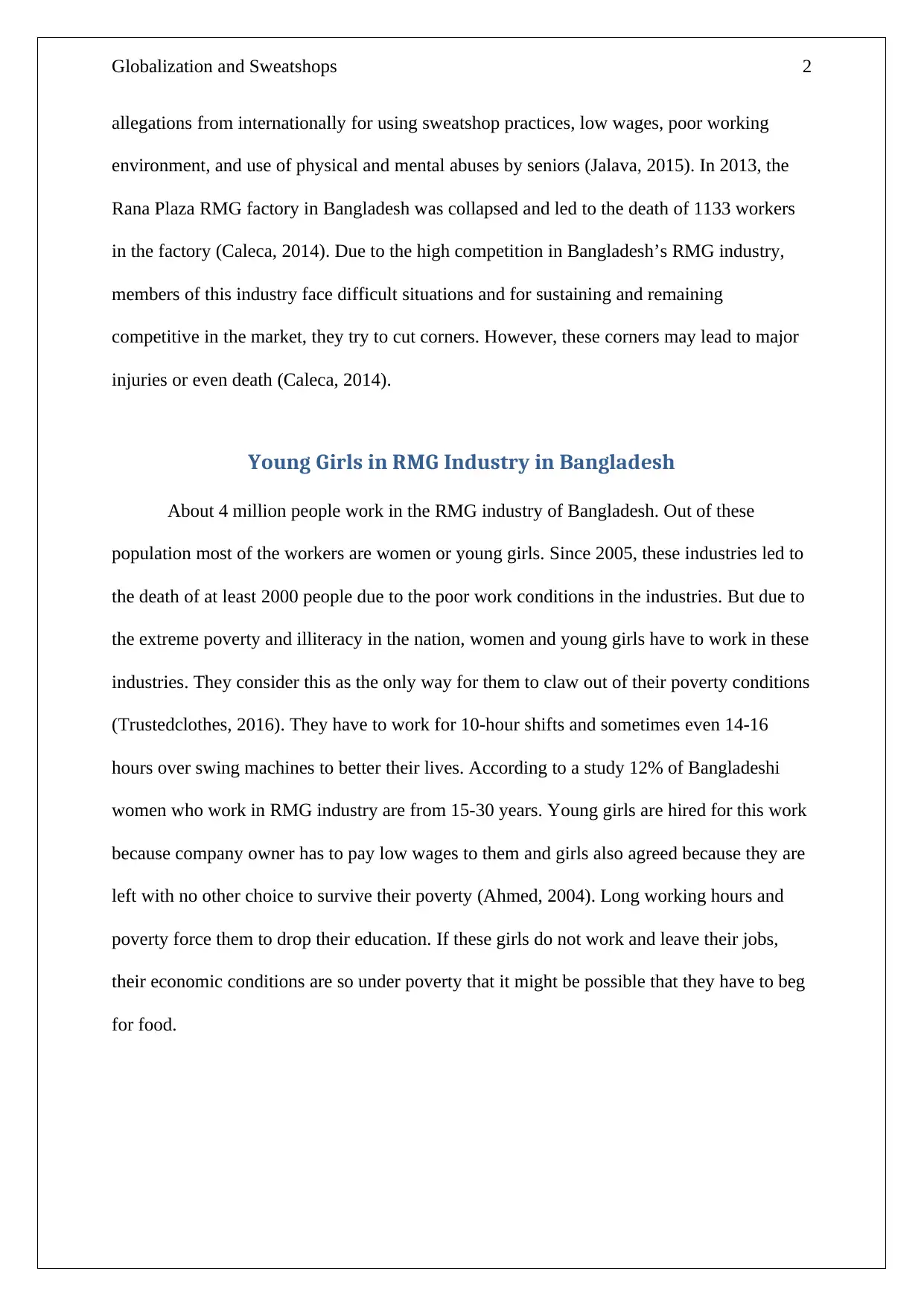
Globalization and Sweatshops 2
allegations from internationally for using sweatshop practices, low wages, poor working
environment, and use of physical and mental abuses by seniors (Jalava, 2015). In 2013, the
Rana Plaza RMG factory in Bangladesh was collapsed and led to the death of 1133 workers
in the factory (Caleca, 2014). Due to the high competition in Bangladesh’s RMG industry,
members of this industry face difficult situations and for sustaining and remaining
competitive in the market, they try to cut corners. However, these corners may lead to major
injuries or even death (Caleca, 2014).
Young Girls in RMG Industry in Bangladesh
About 4 million people work in the RMG industry of Bangladesh. Out of these
population most of the workers are women or young girls. Since 2005, these industries led to
the death of at least 2000 people due to the poor work conditions in the industries. But due to
the extreme poverty and illiteracy in the nation, women and young girls have to work in these
industries. They consider this as the only way for them to claw out of their poverty conditions
(Trustedclothes, 2016). They have to work for 10-hour shifts and sometimes even 14-16
hours over swing machines to better their lives. According to a study 12% of Bangladeshi
women who work in RMG industry are from 15-30 years. Young girls are hired for this work
because company owner has to pay low wages to them and girls also agreed because they are
left with no other choice to survive their poverty (Ahmed, 2004). Long working hours and
poverty force them to drop their education. If these girls do not work and leave their jobs,
their economic conditions are so under poverty that it might be possible that they have to beg
for food.
allegations from internationally for using sweatshop practices, low wages, poor working
environment, and use of physical and mental abuses by seniors (Jalava, 2015). In 2013, the
Rana Plaza RMG factory in Bangladesh was collapsed and led to the death of 1133 workers
in the factory (Caleca, 2014). Due to the high competition in Bangladesh’s RMG industry,
members of this industry face difficult situations and for sustaining and remaining
competitive in the market, they try to cut corners. However, these corners may lead to major
injuries or even death (Caleca, 2014).
Young Girls in RMG Industry in Bangladesh
About 4 million people work in the RMG industry of Bangladesh. Out of these
population most of the workers are women or young girls. Since 2005, these industries led to
the death of at least 2000 people due to the poor work conditions in the industries. But due to
the extreme poverty and illiteracy in the nation, women and young girls have to work in these
industries. They consider this as the only way for them to claw out of their poverty conditions
(Trustedclothes, 2016). They have to work for 10-hour shifts and sometimes even 14-16
hours over swing machines to better their lives. According to a study 12% of Bangladeshi
women who work in RMG industry are from 15-30 years. Young girls are hired for this work
because company owner has to pay low wages to them and girls also agreed because they are
left with no other choice to survive their poverty (Ahmed, 2004). Long working hours and
poverty force them to drop their education. If these girls do not work and leave their jobs,
their economic conditions are so under poverty that it might be possible that they have to beg
for food.
⊘ This is a preview!⊘
Do you want full access?
Subscribe today to unlock all pages.

Trusted by 1+ million students worldwide
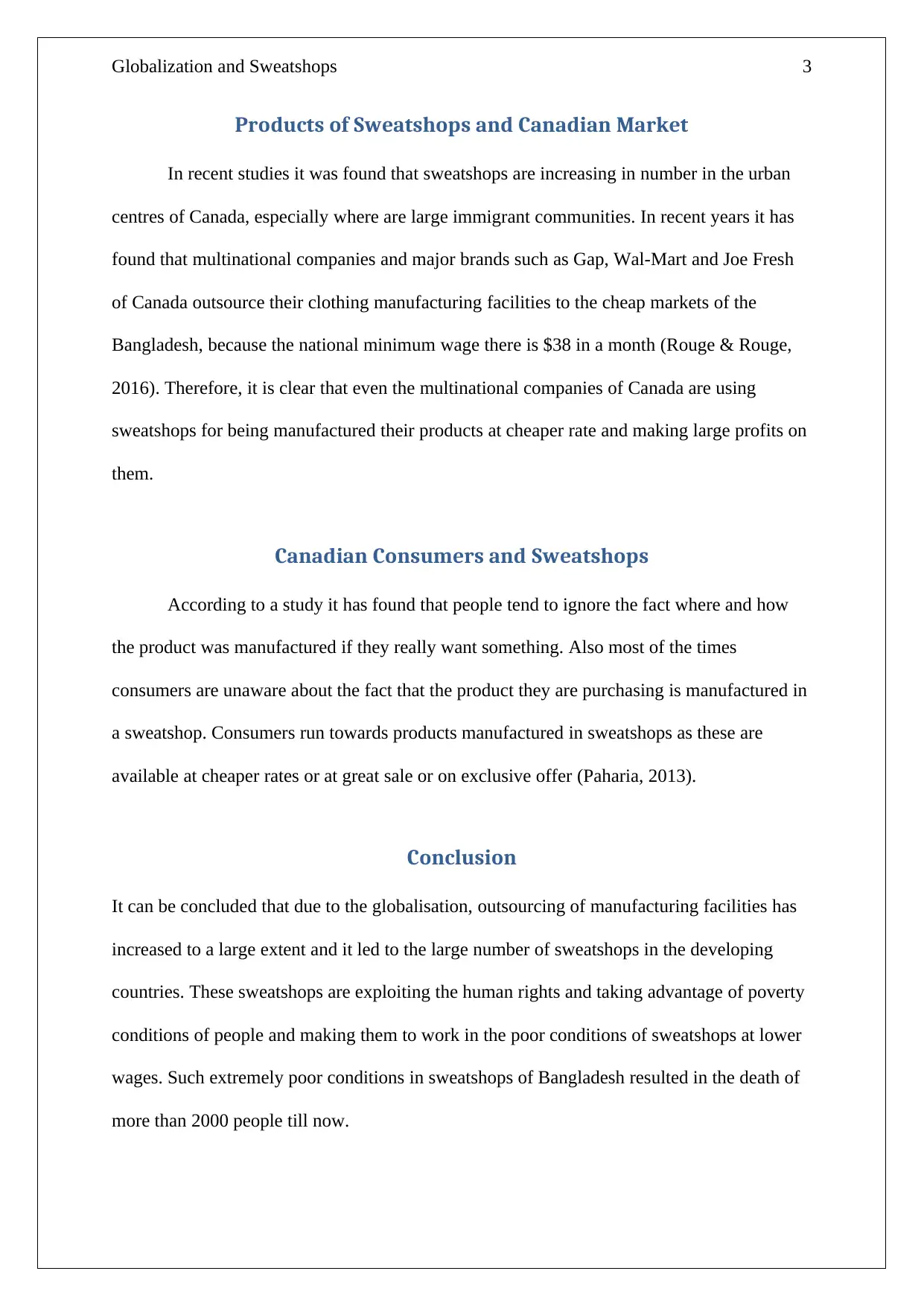
Globalization and Sweatshops 3
Products of Sweatshops and Canadian Market
In recent studies it was found that sweatshops are increasing in number in the urban
centres of Canada, especially where are large immigrant communities. In recent years it has
found that multinational companies and major brands such as Gap, Wal-Mart and Joe Fresh
of Canada outsource their clothing manufacturing facilities to the cheap markets of the
Bangladesh, because the national minimum wage there is $38 in a month (Rouge & Rouge,
2016). Therefore, it is clear that even the multinational companies of Canada are using
sweatshops for being manufactured their products at cheaper rate and making large profits on
them.
Canadian Consumers and Sweatshops
According to a study it has found that people tend to ignore the fact where and how
the product was manufactured if they really want something. Also most of the times
consumers are unaware about the fact that the product they are purchasing is manufactured in
a sweatshop. Consumers run towards products manufactured in sweatshops as these are
available at cheaper rates or at great sale or on exclusive offer (Paharia, 2013).
Conclusion
It can be concluded that due to the globalisation, outsourcing of manufacturing facilities has
increased to a large extent and it led to the large number of sweatshops in the developing
countries. These sweatshops are exploiting the human rights and taking advantage of poverty
conditions of people and making them to work in the poor conditions of sweatshops at lower
wages. Such extremely poor conditions in sweatshops of Bangladesh resulted in the death of
more than 2000 people till now.
Products of Sweatshops and Canadian Market
In recent studies it was found that sweatshops are increasing in number in the urban
centres of Canada, especially where are large immigrant communities. In recent years it has
found that multinational companies and major brands such as Gap, Wal-Mart and Joe Fresh
of Canada outsource their clothing manufacturing facilities to the cheap markets of the
Bangladesh, because the national minimum wage there is $38 in a month (Rouge & Rouge,
2016). Therefore, it is clear that even the multinational companies of Canada are using
sweatshops for being manufactured their products at cheaper rate and making large profits on
them.
Canadian Consumers and Sweatshops
According to a study it has found that people tend to ignore the fact where and how
the product was manufactured if they really want something. Also most of the times
consumers are unaware about the fact that the product they are purchasing is manufactured in
a sweatshop. Consumers run towards products manufactured in sweatshops as these are
available at cheaper rates or at great sale or on exclusive offer (Paharia, 2013).
Conclusion
It can be concluded that due to the globalisation, outsourcing of manufacturing facilities has
increased to a large extent and it led to the large number of sweatshops in the developing
countries. These sweatshops are exploiting the human rights and taking advantage of poverty
conditions of people and making them to work in the poor conditions of sweatshops at lower
wages. Such extremely poor conditions in sweatshops of Bangladesh resulted in the death of
more than 2000 people till now.
Paraphrase This Document
Need a fresh take? Get an instant paraphrase of this document with our AI Paraphraser
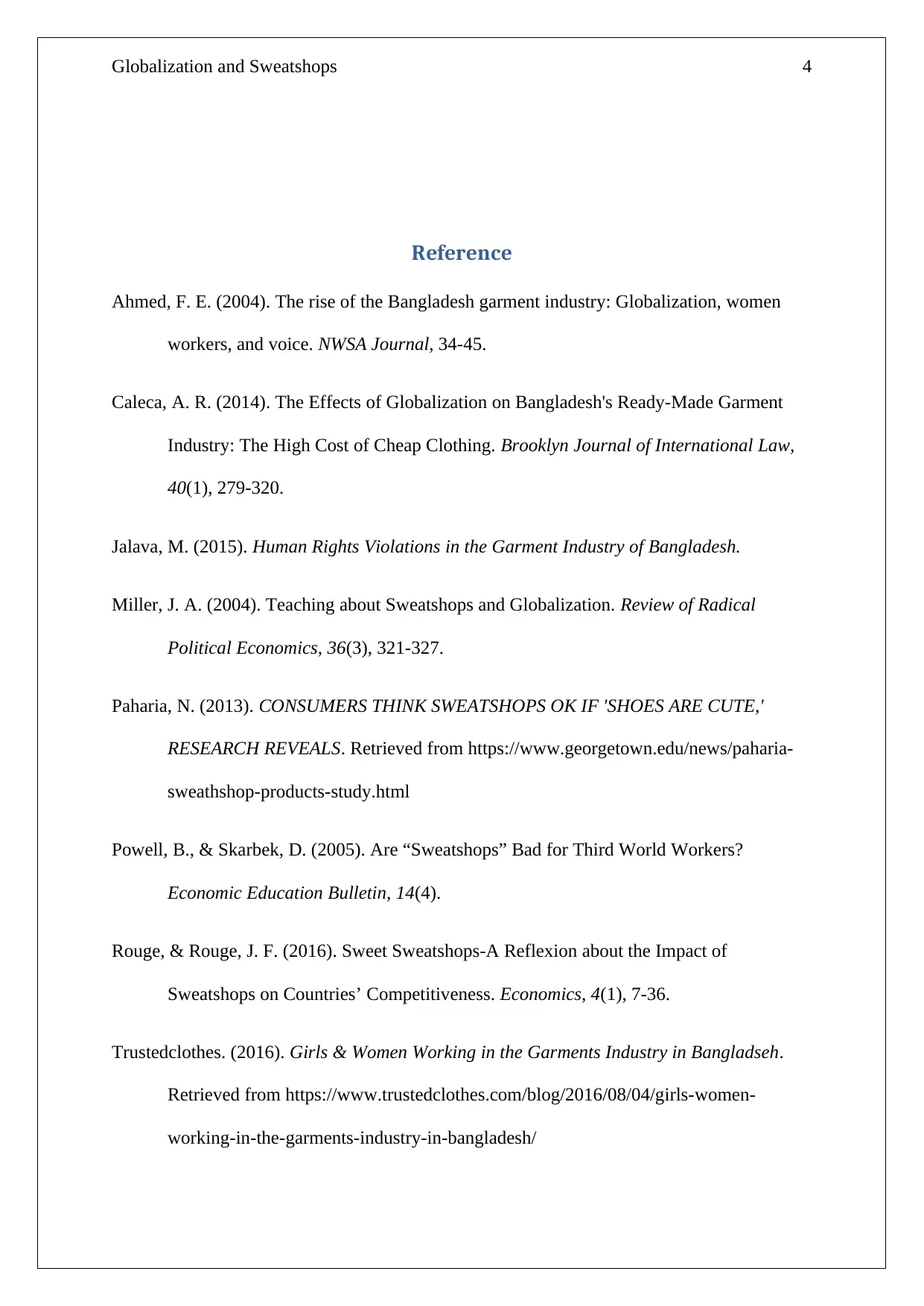
Globalization and Sweatshops 4
Reference
Ahmed, F. E. (2004). The rise of the Bangladesh garment industry: Globalization, women
workers, and voice. NWSA Journal, 34-45.
Caleca, A. R. (2014). The Effects of Globalization on Bangladesh's Ready-Made Garment
Industry: The High Cost of Cheap Clothing. Brooklyn Journal of International Law,
40(1), 279-320.
Jalava, M. (2015). Human Rights Violations in the Garment Industry of Bangladesh.
Miller, J. A. (2004). Teaching about Sweatshops and Globalization. Review of Radical
Political Economics, 36(3), 321-327.
Paharia, N. (2013). CONSUMERS THINK SWEATSHOPS OK IF 'SHOES ARE CUTE,'
RESEARCH REVEALS. Retrieved from https://www.georgetown.edu/news/paharia-
sweathshop-products-study.html
Powell, B., & Skarbek, D. (2005). Are “Sweatshops” Bad for Third World Workers?
Economic Education Bulletin, 14(4).
Rouge, & Rouge, J. F. (2016). Sweet Sweatshops-A Reflexion about the Impact of
Sweatshops on Countries’ Competitiveness. Economics, 4(1), 7-36.
Trustedclothes. (2016). Girls & Women Working in the Garments Industry in Bangladseh.
Retrieved from https://www.trustedclothes.com/blog/2016/08/04/girls-women-
working-in-the-garments-industry-in-bangladesh/
Reference
Ahmed, F. E. (2004). The rise of the Bangladesh garment industry: Globalization, women
workers, and voice. NWSA Journal, 34-45.
Caleca, A. R. (2014). The Effects of Globalization on Bangladesh's Ready-Made Garment
Industry: The High Cost of Cheap Clothing. Brooklyn Journal of International Law,
40(1), 279-320.
Jalava, M. (2015). Human Rights Violations in the Garment Industry of Bangladesh.
Miller, J. A. (2004). Teaching about Sweatshops and Globalization. Review of Radical
Political Economics, 36(3), 321-327.
Paharia, N. (2013). CONSUMERS THINK SWEATSHOPS OK IF 'SHOES ARE CUTE,'
RESEARCH REVEALS. Retrieved from https://www.georgetown.edu/news/paharia-
sweathshop-products-study.html
Powell, B., & Skarbek, D. (2005). Are “Sweatshops” Bad for Third World Workers?
Economic Education Bulletin, 14(4).
Rouge, & Rouge, J. F. (2016). Sweet Sweatshops-A Reflexion about the Impact of
Sweatshops on Countries’ Competitiveness. Economics, 4(1), 7-36.
Trustedclothes. (2016). Girls & Women Working in the Garments Industry in Bangladseh.
Retrieved from https://www.trustedclothes.com/blog/2016/08/04/girls-women-
working-in-the-garments-industry-in-bangladesh/

Globalization and Sweatshops 5
⊘ This is a preview!⊘
Do you want full access?
Subscribe today to unlock all pages.

Trusted by 1+ million students worldwide
1 out of 6
Related Documents
Your All-in-One AI-Powered Toolkit for Academic Success.
+13062052269
info@desklib.com
Available 24*7 on WhatsApp / Email
![[object Object]](/_next/static/media/star-bottom.7253800d.svg)
Unlock your academic potential
Copyright © 2020–2025 A2Z Services. All Rights Reserved. Developed and managed by ZUCOL.





